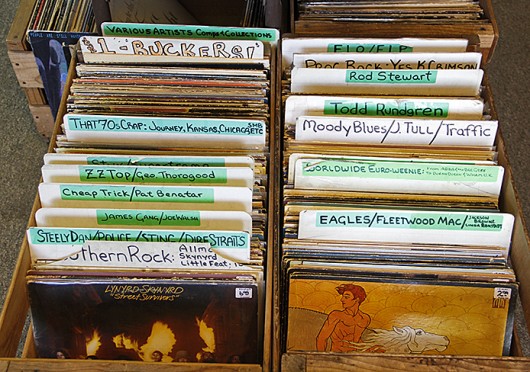
Vinyl records at Used Kids Records, located at 1980 N. High St.
Credit: Ritika Shah / Asst. photo editor
In the heart of the digital music age, vinyl records like those from the 1970s have been making a comeback. Vinyl sales increased by 32 percent in 2013, according to Nielsen SoundScan, with music fans purchasing 1.5 million more albums than in the previous year.
Kyle Siegrist, owner of Lost Weekend Records, located at 2960 N. High St., said his store has seen a similar rise in sales.
“I’d say each year (sales) seem to (have a) 20-30 percent growth over the year,” Siegrist said. “We’ve been here 11 years now and every year it grows by about that much. It’s been a steady increase, each year more and more things seem to be available on vinyl.”
Siegrist said he believes this increase is a result of a number of different reasons, including sound quality and the “retro vibe” vinyl has to it. They key factor, though, seems to be the realness of the product.
“There are different reasons for different people. Some people like the sound and then there are those who are interested in the nostalgic factor,” he said. “It is a tangible, real product for the people who want to go to the store and buy it. It is the memories and the artwork.”
Some Ohio State students agree with Siegrist, and said a vinyl record has more depth than a digital copy.
“One great thing about collecting records is that (each record) has a long history,” said Zak Berman, a fourth-year studying electrical engineering. “I can go out and buy a record that came out today or I can buy one from 50 years ago. That’s pretty neat.”
Berman said he has been collecting vinyl for five years and said he also appreciates the palpable quality of a record.
“Another reason I enjoy buying vinyl over digital is because I can hold it in my hands, read the liner notes, have a large version of the artwork, and so on. These are things that digital music has taken away for the most part,” he said.
Listening to records also allows the music to bring people together, said Chuck Kubat of Magnolia Thunderpussy, located at 1155 N. High St.
“You become lonely, you buy a record and put it on. You listen to it with your friends instead of listening to your iPod,” he said. “Listening to a record is more social. It’s a communal experience, rather than everyone walking around on their own island listening to their own thing.”
For Max Moreland, a fourth-year in political science, the adventure of collecting vinyl can also be a catalyst when it comes to buying music.
“One of the reasons I collect vinyl is for the deal,” said Moreland. “Finding a record that you have been after for a while at a good price is exactly like finding something cool at a yard sale. Also, vinyl of new artists comes with download codes for the digital copies.”
Purchasing newer releases on vinyl can be more expensive though, with prices in the $20-$30 range.
Kubat said the higher price comes from the need to protect the product and the size difference between vinyl and any other type of music.
“What it is, records usually come out and are $20 and include a digital copy, but they are heavy. A box of 30 records weighs a lot, compared to CDs, so the shipping process is more expensive. There is more paper and packaging so the records don’t get beat up,” he said. “If people buy a $20 record, they are going to keep it and not forget about it.”
OSU students, like Moreland, have noticed the high prices.
“The only store that sells a good portion of their records for that much is Magnolia Thunderpussy, and while they definitely have the best selection, they have (expensive) prices,” he said.
Vinyl might require more time and work to listen to, but Siegrist said the effort is a part of the experience.
“You get so much more time with a vinyl record,” he said. “You flip it over and choose a side and song. It’s a little more work. You have to have a certain passion. Vinyl is kind of like the hardback compared to paperback, digital or a CD.”


